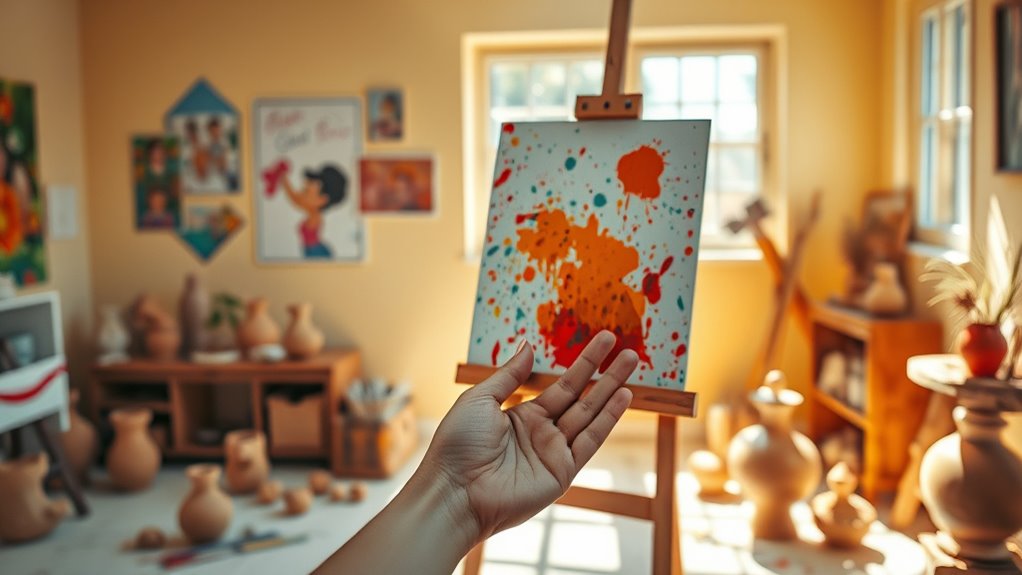Self-compassion is essential for you as an artist, helping you embrace imperfections as part of your creative journey. Acknowledging that flaws can enhance your work fosters authenticity and deep connections with your audience. Instead of aiming for unattainable perfection, celebrate your unique growth and the learning that comes from mistakes. This approach leads to a more fulfilling artistic experience, inviting self-exploration and experimentation. There’s so much more to discover about nurturing your creativity and overcoming perfectionism.
Key Takeaways
- Embracing imperfections in art fosters vulnerability, creating deeper connections with both the artist and the audience.
- Practicing self-compassion allows artists to navigate setbacks without harsh self-criticism, promoting a healthier creative journey.
- Celebrating small successes encourages a positive mindset and reduces the pressure of perfectionism in artistic endeavors.
- Mindfulness techniques enhance awareness, helping artists accept their flaws and focus on the creative process rather than the end result.
- Keeping a process journal can document growth, reinforcing the idea that mistakes are integral to artistic exploration and development.
The Beauty of Flaws in Artistic Expression
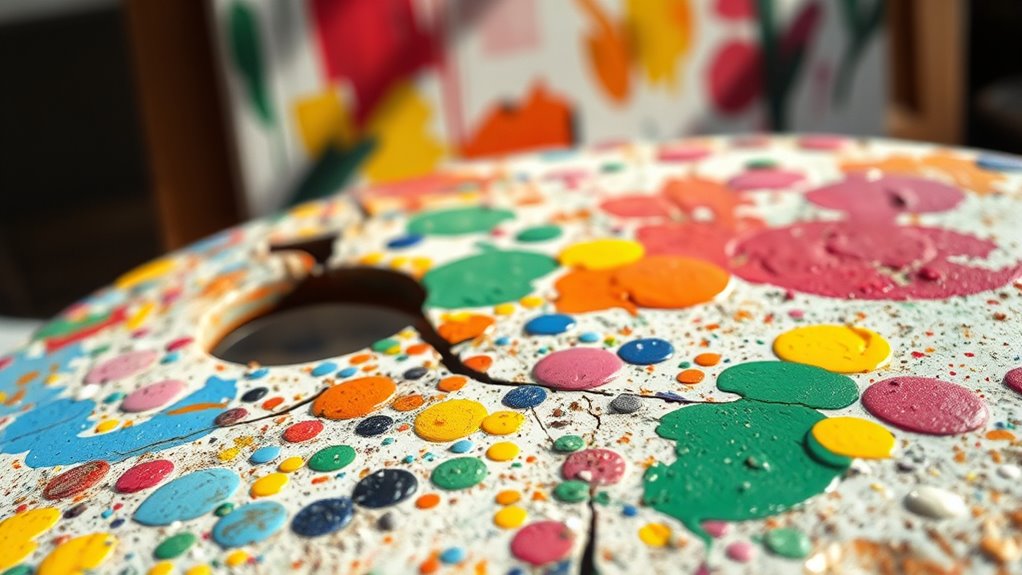
When you embrace the flaws in your artistic expression, you release a raw authenticity that resonates deeply with your audience. Embracing imperfection allows you to convey a deeper story about your creative journey, fostering a connection through shared vulnerability. Audiences often find art that displays imperfections more relatable, as it reflects real emotions and experiences. This acceptance encourages you to take risks in your artistic process, leading to innovative techniques and fresh ideas. Studies show that artists who embrace flaws experience personal growth, reducing anxiety and strengthening their artistic identity. Furthermore, recognizing the importance of emotional manipulation in relationships can inspire artists to explore complex themes within their work. By fostering a growth mindset, you can unlock new dimensions of creativity and resilience in your art, as embracing shared vulnerability can deepen the emotional connection to your audience. Additionally, engaging in continuous learning about your craft can further enhance your ability to express imperfections in meaningful ways.
Understanding the Impact of Perfectionism
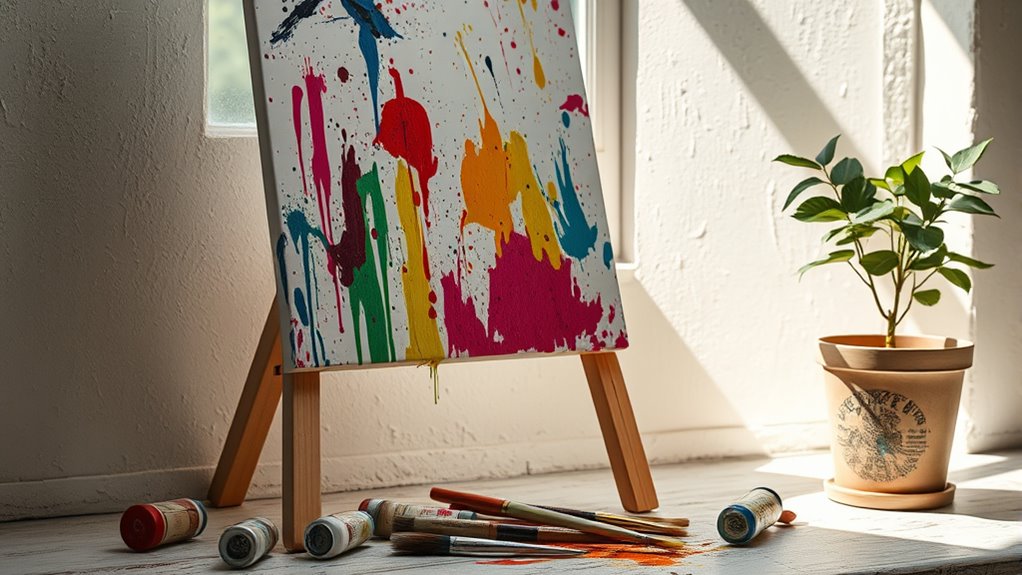
Embracing the beauty of flaws opens the door to understanding how perfectionism can hinder your artistic journey.
Perfectionism often sets unrealistic standards, causing anxiety and depression that affect your mental health. You might find yourself procrastinating, avoiding your creative space, or struggling to finish projects, stifling your expression. Balancing your creative pursuits with work-life balance is essential to maintain a healthy mindset. To combat these feelings, it’s crucial to prioritize hydration and nutrition, as they can significantly impact your mental clarity and overall well-being. Individuals with emotional dysregulation may find that their creative process is particularly affected by these pressures.
It’s important to distinguish between maladaptive and adaptive perfectionism. While maladaptive perfectionism can block your creativity, adaptive perfectionism can inspire you to enhance your skills.
However, feedback from exhibitions or grants may amplify feelings of unworthiness, making rejection feel like failure. This is especially true when visitor analytics reveal that rejection can have a significant impact on self-esteem and motivation.
By embracing imperfection, you can shift your perspective, viewing mistakes as opportunities for exploration and innovation, ultimately fostering greater artistic growth.
The Creative Process: A Journey of Growth

The creative process is all about embracing your artistic evolution. As you learn from mistakes and celebrate your exploration, you reveal new possibilities for growth. This journey is enriched by recognizing that creativity can be cultivated through consistent practice, allowing everyone to enhance their innovative thinking. Engaging with educational toys can further inspire imagination and creativity, as they stimulate cognitive growth and promote problem-solving skills. Additionally, understanding market research made simple can help artists identify their audience and refine their creative direction, ultimately leading to greater success in their artistic endeavors. Furthermore, incorporating STEM toys into your routine can significantly enhance creativity and problem-solving abilities through interactive play.
Embracing Artistic Evolution
Artistic evolution unfolds as a dynamic journey where each creation captures your growth and experimentation. Embracing imperfection allows you to transform mistakes into stepping stones for deeper learning and growth. When you focus on the experience, rather than a flawless end product, your art becomes richer and more authentic. Self-compassion plays a crucial role, helping you forgive perceived flaws and fostering patience in your creative process. Additionally, practicing nighttime meditation can enhance your mental clarity, allowing for more focused artistic expression. The beauty of minimalism can also inspire you to appreciate the essence of each piece without the distraction of excess. Documenting your evolution can reinforce this mindset, while understanding the AI bifurcation illustrates how technology can complement your creative endeavors. Cultivating a growth mindset encourages you to view challenges as opportunities for artistic development.
| Stage | Embracing Imperfection | Learning and Growth |
|---|---|---|
| Initial Creation | Accepting flaws | Discovering new ideas |
| Mid-Process | Experimenting boldly | Developing techniques |
| Final Piece | Celebrating uniqueness | Reflecting on progress |
Learning From Mistakes
While mistakes might feel intimidating in the moment, they often serve as the most powerful catalysts for your growth as an artist. Embracing mistakes allows you to explore new techniques and discover unexpected outcomes in your art. Essential oils for aromatherapy can also enhance your creative environment, making it more conducive to experimentation and inspiration. For instance, using eucalyptus oil can create a refreshing atmosphere that stimulates your senses and encourages innovative thinking. Jesus’ teachings emphasize the importance of love and compassion, which can inspire you to approach your art with a more forgiving mindset.
Instead of viewing imperfections as failures, see them as opportunities—each flaw contributes to your overall development and understanding of your craft. This shift in mindset reduces anxiety, making your creative journey more fulfilling.
Keeping a process journal can help you reflect on these moments, reinforcing the idea that errors are essential to your evolution. By experimenting freely, you’ll uncover your unique artistic voice and style, ultimately enriching your creative process and the art you create. Additionally, just as glycolic acid aids in exfoliation, these creative missteps can enhance your growth by promoting new perspectives and ideas.
Celebrating Creative Exploration
Creative exploration fuels your growth as an artist, revealing layers of your unique expression. Embracing flaws during this journey opens the door to experimentation and risk-taking, leading to unexpected discoveries that enrich your work. By recognizing the importance of continuous learning, you can further enhance your creative process. Engaging in mindfulness practices can also deepen your connection to the creative process, allowing for greater awareness and presence in your work.
When you accept imperfection, you reduce anxiety and self-doubt, allowing for a more authentic expression of your emotions. Keeping a process journal can help you document your artistic growth and celebrate small successes, reinforcing the value of the creative journey over the final product.
Engaging with community feedback and sharing your work fosters connection and support, reminding you that vulnerability is essential in the creative exploration process. Embrace these moments; they’re where true growth occurs. Additionally, understanding color accuracy can enhance how your artistic vision is perceived by others.
Cultivating Self-Compassion as an Artist

As you commence your artistic journey, cultivating self-compassion becomes essential for maneuvering the inevitable ups and downs.
Recognizing that making mistakes and imperfections are part of the creative process allows you to build resilience and foster a healthier mindset. Research shows that self-compassion is linked to improved mental health, helping you tackle the challenges of creativity while reducing anxiety tied to perfectionism.
By embracing self-compassion, you can shift from harsh self-criticism to kindness, encouraging greater artistic exploration and a diminished fear of failure.
Incorporating self-compassion practices like positive affirmations and mindfulness can help you acknowledge your unique journey and emotional experiences, making you better equipped to handle setbacks and criticism in your creative endeavors.
Embracing Vulnerability and Authenticity
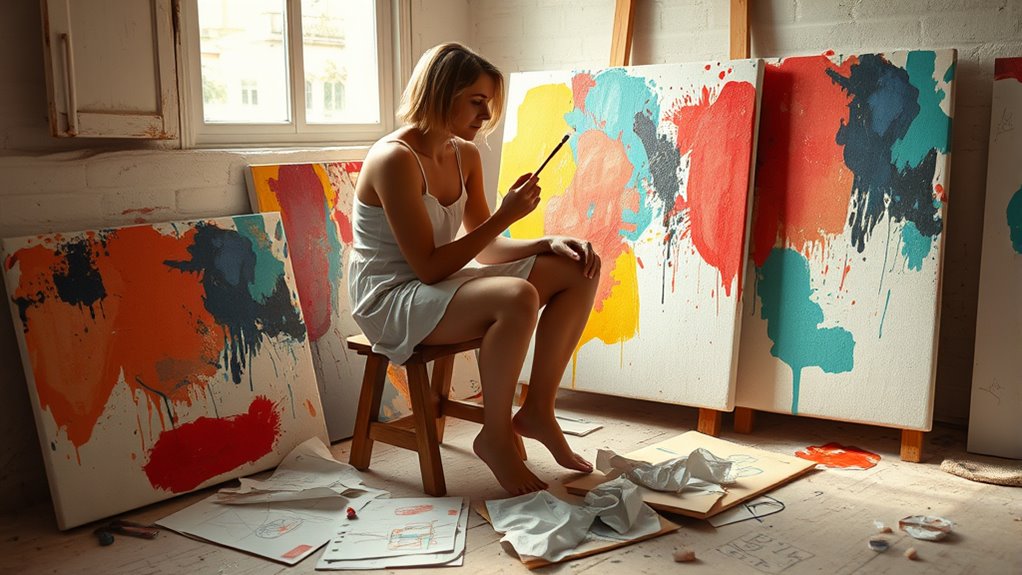
Embracing vulnerability in your art can create a powerful connection with your audience.
When you share your authentic self, imperfections become the heart of your expression, making your work more relatable and impactful.
The Power of Vulnerability
When you allow yourself to be vulnerable in your art, you invite deeper connections with your audience, fostering a sense of authenticity that resonates on multiple levels.
Embracing vulnerability means sharing your personal stories and imperfections, which can create a community among those who relate to your experiences. This openness can quiet your inner critic, enabling you to explore creativity without fear of judgment.
By revealing your flaws, you nurture self-acceptance, strengthening your artistic identity and resilience against criticism. Additionally, your willingness to share vulnerable work might inspire others to embrace their own imperfections, creating a ripple effect of self-compassion within the artistic community.
Authentic Expression in Art
Authentic expression in art thrives on the willingness to be vulnerable, allowing you to convey your true emotions and experiences. By embracing vulnerability, you create a bridge to your audience, inviting them to connect with the genuine essence of your work.
Imperfections in your art reflect your journey, adding depth and relatability that resonate with viewers. Research shows that people appreciate authenticity, engaging more deeply with struggles and flaws depicted in your creations.
This openness encourages you to take risks and experiment, leading to unique artistic outcomes. Ultimately, embracing authenticity not only fosters your personal growth but also invites others to reflect on their complexities, promoting a shared understanding of the human experience.
Practical Strategies to Overcome Perfectionism
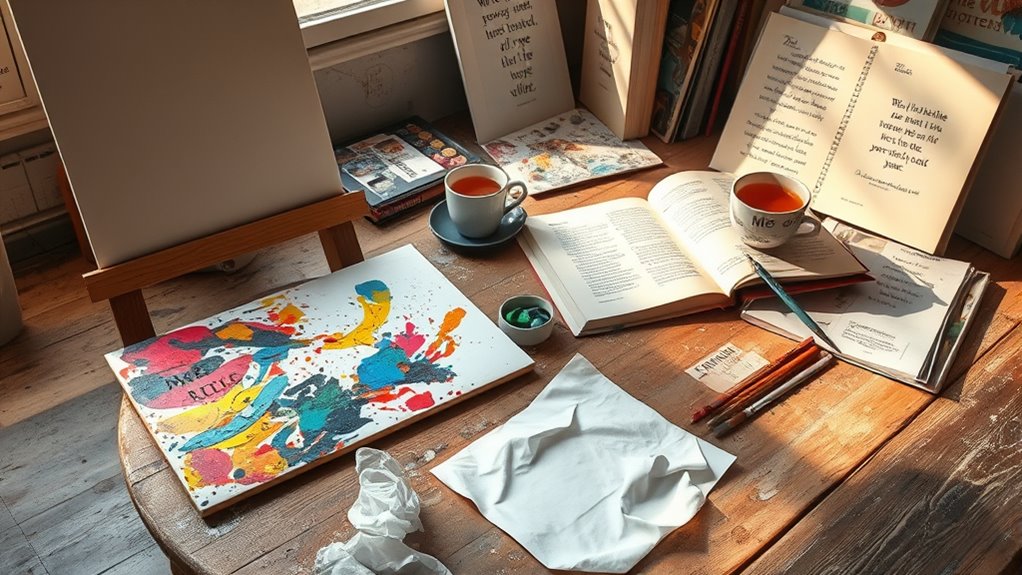
To combat the grip of perfectionism, you can adopt practical strategies that make the creative process more enjoyable and less intimidating.
Start by setting time limits on edits to avoid getting stuck in endless revisions. Engage in low-pressure creative exercises, like quick sketches or using inexpensive materials, allowing yourself to experiment and make mistakes without anxiety.
Celebrate small successes with a good, better, best strategy, breaking larger goals into manageable steps.
Intentionally leave imperfections in your artwork; this not only challenges the idea of perfection but also enhances your creative experience.
Building a Supportive Artistic Community

As you navigate the ups and downs of your artistic journey, building a supportive community can greatly enhance your experience. Connecting with others who share your passion for art fosters emotional support and validation, making you feel less isolated.
Here are some ways to cultivate this environment:
- Engage in local art organizations or online platforms to meet like-minded peers.
- Participate in group critiques to normalize receiving feedback and learn from diverse perspectives.
- Share personal stories to promote vulnerability and create a safe space for expression.
- Collaborate on art projects or exhibitions to strengthen relationships and embrace imperfection.
Frequently Asked Questions
What Is Self-Compassion for Making Mistakes?
Self-compassion for making mistakes means treating yourself with kindness when things don’t go as planned.
Instead of harshly criticizing yourself, you recognize that everyone makes errors. You remind yourself that mistakes are part of growth and learning.
By embracing this mindset, you can reduce anxiety and build resilience. It’s about forgiving yourself, allowing for imperfections, and focusing on the journey rather than just the outcome.
This way, you cultivate a healthier relationship with your experiences.
How to Get Rid of Perfectionism in Art?
You’ve got to banish perfectionism like a stubborn stain that just won’t budge!
Start by diving into low-pressure creative practices—set a timer and sketch like there’s no tomorrow!
Embrace those little “oops” moments; they’re not failures, they’re gold!
Celebrate every tiny win, and soon enough, you’ll redefine success.
Surround yourself with fellow artists who get it, turning imperfections into badges of honor.
Let go, and watch your creativity soar!
What Is the Art That Embraces Imperfections?
Art that embraces imperfections often showcases the beauty in flaws, inviting you to connect with its authenticity.
It reflects an artist’s journey, capturing growth and vulnerability. You might notice unexpected elements or raw techniques, encouraging you to appreciate the creative process.
Leaving mistakes intentionally can spark innovation, allowing you to explore your own artistic voice.
Ultimately, this approach resonates with viewers, fostering a sense of relatability and encouraging personal acceptance of imperfections.
Which Artists Were Perfectionists?
You’ll find many artists known for their perfectionist tendencies.
Pablo Picasso often destroyed works that didn’t meet his high standards, while Vincent van Gogh’s obsessive attention to detail led to emotional turmoil.
Michelangelo frequently reworked his sculptures until they were flawless.
Georgia O’Keeffe refined her techniques and compositions to create her unique style, and Ludwig van Beethoven rewrote his compositions multiple times, showcasing the pressure he felt to achieve musical excellence.
Conclusion
In embracing self-compassion, you reveal the true essence of your art. Remember the story of Vincent van Gogh, whose struggles with perfectionism fueled his vibrant, emotive paintings. By accepting your flaws and focusing on growth, you can transform your artistic journey. Surrounding yourself with a supportive community can further help you celebrate your uniqueness. So, let go of the need for perfection and allow your creativity to flourish—your imperfections might just be your greatest strengths.

